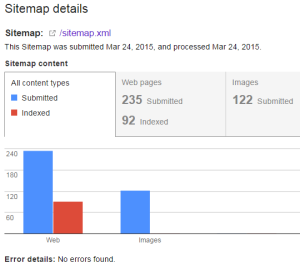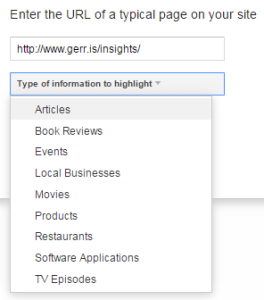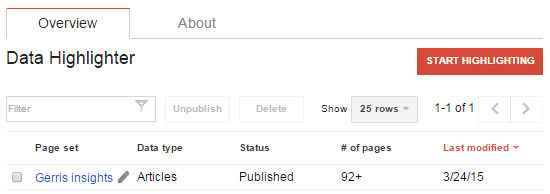Last week I shared a couple Google Webmaster Tools tips and tricks with you. This week, I have two more: sitemaps and data highlighting. I saved the best for last. If you have been obsessing on your Google Analytics numbers, cruising the SEO boards, and picking through MOZ and Woorank, wondering what Google wants and needs from you while scratching your head, then let me enlighten you!
Google wants you to be successful! They want you to do all the free work in the world on your own site to make it easier for them to make the handoff from Google Search to Google Found, where your site and your content is the Found.
So, instead of guessing what Google needs, you too can work on complying to Google’s simple list of essential changes that you will need to make in order to build the sort of seamless web of trust that Google demands from you before you become a respected and essential go-to in the wide world of search. And no, it has less to do with backlinks and google juice from PR6-9 sites circa 2015 than it has in the recent past.
The sort answer is simple: having a wicked quick, factual, easy to understand, mobile-optimized, machine-structured, beautiful site is probably the key as we move into Google’s future. It used to be that all you needed to have your site perform was function; however, Google abhors both a vacuum and a high bounce rate.
If the visitors who Google passes off to you in good faith via mobile, tablet, or web bounce for whatever reason, you’re toast. Being visually- and mobilely-appealing is as important in 2015 on as is being highly relevant. People are as likely to bounce if they don’t like how your site looks or responds as they are if they don’t like what you have to say, sell, or share.
So, let’s explore what Google says about structured data, how both Google Webmaster Tools and Bing Webmaster Tools demand that you have a Sitemap.xml on your site; and, if you don’t, how you can use Google’s data highlighter to train Google up as to how your site’s content and pages are structured explicitly through an interactive “show me” that Google’s happy to walk you through. Finally, if your site isn’t fast enough in receiving Google’s search handoff then you won’t be getting that handoff for much longer.
And, aren’t you mobile native yet? No? Pathetic!
Google Only Speaks Structured Data (Sitemap.xml)
 In a post-RSS and ATOM world, Google needs a little help, especially when everyone’s trying to get so clever. I have a client who had decided to overrule Drupal’s default slugs and posts everything with the same URL structure: www.domain.org/blog-post, www.domain.org/site-page, www.domain.org/contact-form, www.domain.org/organization-news, www.domain.org/about-page, www.domain.org/press-releases, www.domain.org/articles, and www.domain.org/announcements are all different categories and types of pages.
In a post-RSS and ATOM world, Google needs a little help, especially when everyone’s trying to get so clever. I have a client who had decided to overrule Drupal’s default slugs and posts everything with the same URL structure: www.domain.org/blog-post, www.domain.org/site-page, www.domain.org/contact-form, www.domain.org/organization-news, www.domain.org/about-page, www.domain.org/press-releases, www.domain.org/articles, and www.domain.org/announcements are all different categories and types of pages.
 Blog posts, articles, press releases, and announcements are all considered to be ‘articles’ by Google but since my client hasn’t defined an easy-to-understand URL or site formatting that Google can intuit and ‘understand,’ it needs a strong assist, and Google hopes that a well-made sitemap will do that trick.
Blog posts, articles, press releases, and announcements are all considered to be ‘articles’ by Google but since my client hasn’t defined an easy-to-understand URL or site formatting that Google can intuit and ‘understand,’ it needs a strong assist, and Google hopes that a well-made sitemap will do that trick.
Google needs your sitemap for two reasons: to understand your site (content, and site architecture) and to grok when and how often you make site updates. If you don’t have a dynamic or frequently-updated sitemap.xml document on your site, you’ll lose out to those who do. Yes, Google can spider your site ‘by hand’ but why care about your site when other sites with very similar content are willing to take the extra step of complying with Google’s wishes.
Sitemaps can pass Google a lot more than just site structure, updates, and content, such as hreflang content and whatnot, but don’t worry to much about advanced features, care more about having one at all. It’s not guaranteed (well, it’s offered by default on Squarespace, which is convenient. If you’re on Squarespace, it can be found on www.yourdomain.com/sitemap.xml).
You Can Lead a Google to Structure (Data Highlighter)
 If, like my client, you don’t have a sitemap yet installed on your site, you’re not ruined.
If, like my client, you don’t have a sitemap yet installed on your site, you’re not ruined.
Google has a very mind-numbing tool that can help you walk Google through your entire site, page-by-page and link-by-link, allowing you to explicitly define each and every page according to exactly what you’re saying, how you’re saying, by whom, and then down the rabbit hole of granularity, all the way down to content as specific as:
- Articles
- Book Reviews
- Events
- Local Businesses
- Movies
- Products
- Restaurants
- Software Applications
- TV Episodes
 So, what can this do for you? Well, since Google’s really still so stupid, it’ll be your job to actually give Google’s spiders and bots a first-person tour of your entire site.
So, what can this do for you? Well, since Google’s really still so stupid, it’ll be your job to actually give Google’s spiders and bots a first-person tour of your entire site.
And, Google Data Highlighter is a little like their Google Authorship program (RIP), except in the case of the highlighter tool, it’s your job to do all the work yourself.
“What’s in it for me?” What’s in it for you? Well, according to Google, it will “improve your look in search” and “let users see your key information right in search results.”
 So, if you ever wonder how movie, event, and news sites actually have their site content integrated in search results and felt green with jealousy? Well, this is how.
So, if you ever wonder how movie, event, and news sites actually have their site content integrated in search results and felt green with jealousy? Well, this is how.
So, even if — when — Google asks you go through an hours worth of pages, correcting each attempt at structuring your data that Google tries, do it until you’re done. It’s worth it.
If you’re willing to bring a Google to structured data and then have the patience to wait until it drinks, you’ll be forever rewarded, I promise.
Page Speed and Optimizing for Mobile
Psyche. I think I’ll put off the important subjects of how important page speed (and quickness) is to Google and how essential being mobile-ready and mobile-optimized is for your present and future Google Search success until next week because I am on holiday in Paris and really want to take a jog in le Jardin des Tuileries before it gets too late so I’ll sign off for now. Go git ’em, Tigre!






